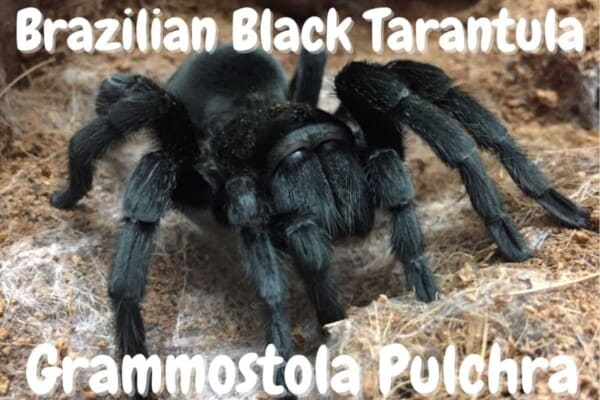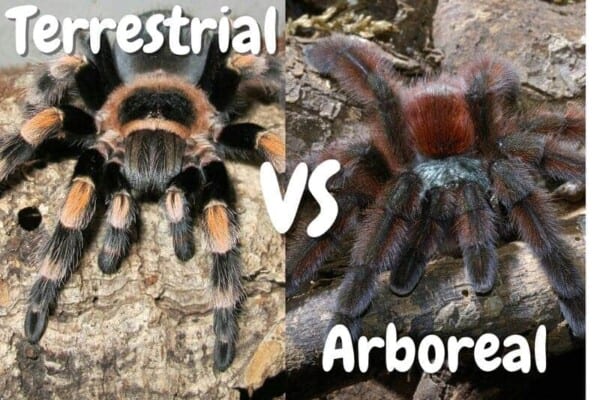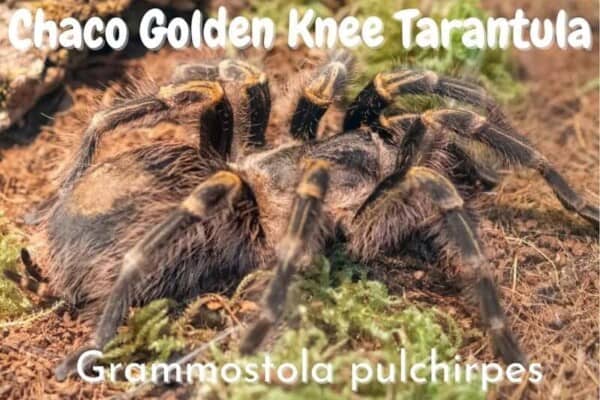Tarantulas are relatively easy pets to have. In fact, they are usually perfectly happy being left completely alone besides feeding and the occasional enclosure cleaning. However, you do want to make sure you get their enclosure right since that is where they will be spending pretty much their entire life in there, which includes picking out the right substrate.
In this article, we are going to go over all the things you need to consider when picking out a substrate to use in your tarantula’s enclosure. Additionally, you will find a guide to eight great substrates for you to consider purchasing.
8 Best Tarantula Substrates Available On The Market
If you are wanting a coconut fiber substrate for your tarantula, Josh’s Frogs Coco substrate is a great option for tarantulas, even though it technically says reptile substrate on the packaging. This substrate is completely biodegradable and organic, which means not only is it good for a tarantula, but it is good for the environment.
When you go to put it in your tarantula’s enclosure, you are going to soak the substrate so it can expand, drain the excess water, and lay it out in the enclosure. This coconut fiber substrate is great at absorbing messes and odors, and it also helps maintain humidity in the enclosure.
- It comes in brick form, so it is easy to store
- Has great water and odor absorbency
- Looks natural in your tarantula’s enclosure
- It takes 30 minutes to expand fully, which can extend the cleaning process
Zoo Med is another great brand of coconut fiber that you can trust. You can get it loose like this one or sold in compressed bricks that are easy for storing but require expansion before you can use them. Zoo Med is one of the most popular coconut fiber substrate brands, so you can trust that it is safe for your tarantula.
Zoo Med Eco Earth is also one of the cheaper coconut fiber substrates on the market. It is resistant to mold and can be used damp for tarantula breeds that require consistent levels of high humidity or dry for breeds that do not need the humidity.
- It is relatively inexpensive for coconut fiber substrate
- It can be used wet or dry depending on your tarantula’s need
- It is resistant to mold
- Tends to dry out quickly
If you are wanting to mix vermiculate into another substance like topsoil, Josh’s Frogs Vermiculite is a brand that you can trust is safe for your tarantulas. While it is possible, it generally is not recommended that you use vermiculite on its own as a substrate for your tarantula; however, when mixed in with another substrate, it can retain moisture and keep the soil at an ideal humidity level.
Some tarantulas do not like walking on or burrowing in substrates that have vermiculite in them. If this is the case for your tarantula, you may have to do multiple substrate changes close together, which could stress out your tarantula even more. If you have two terrariums or plastic containers, and you don’t know your tarantula’s preferences just yet, it might be best to test which one your tarantula likes burrowing in – with or without vermiculite.
- Vermiculite is highly absorbent
- It will help keep humidity levels high in the enclosure
- Very light and mixes easily into other substrates
- Some tarantulas do not like vermiculite, even mixed in with other substrates
Unlike some of the other substrates on this list, this Bio Dude Terra Aranea substrate is designed specifically for animals like tarantulas, scorpions, and isopods. It is specifically formulated to provide these kinds of animals with everything they need. It is perfect for tunneling and burrowing, and when your tarantula does burrow, it will help with shedding, respiration, and hydration.
It also will help you keep your tarantula’s ecosystem thriving. You can plant a huge variety of plants in it, it helps maintain humidity, and it allows for proper aeration and drainage. It pretty much offers everything that you might need from a tarantula substrate.
- Specifically formulated for tarantulas
- Allows for proper aeration, drainage, and maintains humidity
- Perfect for tunneling and burrowing
- A bit pricey in comparison to some other kinds of substrates
We already took a look at one Zoo Med substrate, but if you do not want to go with a coconut fiber substrate, this bedding is another option. It is made from 100% natural cypress mulch. Some people like the look of mulch in their tarantula’s enclosures, while other people do not like any kind of mulch in their tarantula’s enclosure, even mixed in with other substrates. This is up to personal preference, but you probably do not want to use this for a burrowing tarantula.
On the other hand, it works great if you are needing a bump in humidity. When cypress mulch is bagged, it starts to break down some, which causes the natural release of moisture into the space around it.
- Looks great in your tarantula’s enclosure
- Very resistant to mold growth
- Helps to raise humidity levels
- Not great for burrowing or tunneling
If you are looking for a substrate that will work for your burrowing tarantula, the Josh’s Frogs Dig-it substrate is a great option. It is extra soft, so it will not hurt your tarantula at all to dig down in it, even when he is shedding and extra sensitive.
It is also a great substrate for climate control. If you need to keep the enclosure arid or lower the humidity level, it can be kept dry. On the other hand, if you need to mimic a more tropical climate, you can consistently mist it to accomplish that.
- Extra soft and safe for your tarantula is shedding
- Allows for easy climate control
- Perfect for digging, burrowing, and tunneling
- You may have to buy a lot to fill an enclosure
Critters Comfort Insect & Arachnid Habitat Substrate is another great coconut fiber substrate if that is the route you want to go. It is great at absorbing moisture and mess without clumping up and becoming impossible to burrow in. Additionally, it is all-natural without any added odors or chemicals that could be dangerous for your tarantula.
It is great for burrowing species, but it is also great if you are considering incubating eggs. Remember to do your research before trying to raise tarantula slings.
- It is a completely safe and all-natural coconut substrate
- Great for absorbing moisture and mess without clumping
- A great option if you are incubating eggs
- You get more when you buy compressed coconut fiber
The last substrate on this list for you to consider is the Zilla Jungle Mix. It comes in three different sized bags (4-quarts, 8-quarts, and 24-quarts), so you can get whichever bag you need to fill your tarantula’s enclosure.
It is all-natural and made of a blend of sphagnum moss and fir shavings. The blend is great at absorbing water and mess of all sorts, and it will help you retain high humidity levels in your tarantula’s enclosure if you need to. It promotes safe digging, breeding, and egg incubation and is ideal for all sorts of species, including tarantulas. If you keep frogs, geckos and snakes, it’s a good option too.
- Made of a blend of sphagnum moss and fir shavings that are great at absorbing moisture
- It helps you retain a high layer of humidity
- It promotes digging and burrowing
- it is not a good substrate if you need a dry enclosure, like for desert tarantulas
What is A Tarantula Substrate?
A substrate is just the technical name for the material that you place at the bottom of an animal’s enclosure. Most small animals need some sort of substrate at the bottom of their cage or enclosure, including tarantulas. Proving the proper substrate is key for your tarantula’s overall health and happiness because they will spend pretty much their entire life in that enclosure crawling around or burrowing in the substrate.
A good substrate will keep your tarantula’s enclosure dry and allow your pet to live comfortably. Many substrates will also help mask the smell of any unpleasant odors in between cleaning.
The Best Types of Substrates for a Tarantula
1. Coconut Fibre
Coconut fiber is a lot of people’s favorite substrate when it comes to tarantulas. It has great absorbency levels, which will help keep humidity low, and it is also perfectly safe for burrowing species like tarantulas. It also looks great in enclosures, which is always a benefit. It can be more expensive when compared to other substrates and does take some preparation, but many people find that the benefits far outweigh the cons.
2. Topsoil, Potting Compost, and Potting Soil
If you are looking for a slightly cheaper option when it comes to a substrate for your tarantula, you could consider getting soil or potting compost. These substances will both texturally and visibly mimic the forest floor where your tarantula might have lived if he was in the wild. It looks natural and works great for burrowing spiders without the cost of coconut fiber. However, it can become muddy, and you have to make sure you get a high-quality substrate.
3. Peat Moss
Peat Moss is an okay substrate for a tarantula. It has great absorbency, looks amazing, and can be mixed with other products such as topsoil. However, peat moss by itself is not a great substrate by itself because your tarantula will not be able to burrow in it.
4. Vermiculite/Perlite And Spagnum Moss
There was a time when these different substrates were considered the perfect substrate for tarantula; however, the opinion has changed in recent years. Now it is generally believed that these substrates are better as additives than standalone. It can add extra absorbency and provide a more natural look inside the enclosure.
Types of Substrates To Avoid for a Tarantula
1. Pine and Cedar Products
Substrates made from cedar or other conifers have sap residue that can be very dangerous for tarantulas. Therefore, you do not want to use any products that are made from pine or cedar.
2. Bark Chips
Bark chips, even those that are finer, should be avoided. They do not absorb moisture well and therefore mold or even rot in warm, humid environments. It is also impossible for tarantulas to properly burrow in it.
3. Corn Cob Granules
Corn cob granules are sometimes used for reptiles, but they should not be used in warmer or humid environments like tarantula enclosures. They need to be changed out constantly, which can be stressful for your spider.
4. Sand
You might feel like sand is an okay substrate because your tarantula can easily burrow in it, but it completely lacks the ability to absorb or retain water. In fact, if the sand becomes muddy, the burrows might fill up, which can be dangerous for your tarantula.
5. Gravel or Aquarium Gravel
There are a lot of reasons why you should not use gravel as a substrate for your tarantula. It can be sharp, which can hurt your tarantula, and even if it isn’t. he probably will not like walking on it and may even try to climb up things to avoid it.
6. Fertilizers
Any fertilizers or things with added chemicals can be dangerous for your tarantula. The chemicals could poison your pet, irritate its exoskeleton, or hurt its lungs or respiratory system.
How Do I Select My Substrate?
There are a couple of things that you want to consider when you are picking a substrate. For the most part, you want to consider what the substrate needs to do and decide which materials will do that best.
- Terrestrial or arboreal tarantulas: You need to consider what kind of tarantula you are getting. For instance, most ground-dwelling species do not have any humidity requirements and can live perfectly happily with soft bedding. On the other hand, burrowing species need a substrate like coconut fiber that is safe for making strong burrows. Finally, tree-dwelling species need high humidity. You want something that absorbs moisture, and you might even want to mix in moss.
- Temperature: The substrate acts as a temperature buffer. It keeps heat stored and will release it slowly when the air starts to cool off around you.
- Humidity: You need to maintain a certain level of humidity in your tarantula’s enclosure. A substrate helps absorb moisture and keep the enclosure at that required level. The best substrates will not only absorb water that you spray into the enclosure but releases it slowly over a long period of time.
- Burrowing: Most tarantula breeds are burrowing species, which means they will be much happier if they live on a substrate that is safe for burrowing. It needs to be a substrate light enough to dig in, and that won’t turn muddy as soon as it is touched by water.
- Aesthetics: The proper substrate can help give the inside of your tarantula’s enclosure a great, natural look. You will spend a lot of time looking at your tarantula’s enclosure, so you might as well like how it looks.
Can I Make My Own Substrate?
Yes and no. You can take different materials to make your own substrate mix. You might mix a couple of different substances like topsoil and a few different kinds of moss. This will allow you to get the look and function that you like best out of your substrate.
However, you generally do not want to just make your own substrate by just going out in your backyard and picking up some random materials because you won’t know for sure what is safe and what is not.
How Do I Prepare The Substrate?
How you prepare substrate depends on the kind that you get. Coco fiber substrate, for example, takes expanding. You generally have to leave the coconut fiber in water for an hour or two to give it time to expand. On the other hand, things like topsoil or potting soil do not take much preparation at all. All you have to do is lay it out in the bottom of the enclosure and finish setting up the cage.
How Often Should I Change The Substrate?
You do not need to completely change out your tarantula’s substrate all that often. In fact, if you are changing your tarantula’s substrate more than once or twice a year, you are probably unnecessarily stressing out your tarantula. You only need to replace it when it starts to look really dirty. Other than that, you can stick with the occasional spot cleaning and scooping out any major dirt or mess.
Related articles:
Resources and further reading:
- Adaptation of the spiders to the environment: the case of some Chilean species, Mauricio Canals, Claudio Veloso, Rigoberto Solís
- Soil preference and burrow structure of an endangered tarantula, Brachypelma vagans (Mygalomorphae: Theraphosidae), Salima Machkour M’rabet, Yann Hénaut, Alejandra Sepúlveda
Contents
- 8 Best Tarantula Substrates Available On The Market
- 1. Josh’s Frogs Coco Cradle Brick
- 2. Zoo Med Eco Earth Loose Coconut Fiber Substrate
- 3. Josh’s Frogs Vermiculite
- 4. Terra Aranea Substrate by The Bio Dude
- 5. Zoo Med Forest Floor Bedding
- 6. Josh’s Frogs Dig-It
- 7. Critters Comfort Insect & Arachnid Habitat Substrate Natural Coconut Fiber
- 8. Zilla Reptile Terrarium Bedding Substrate Jungle Mix Moss & Fir
- What is A Tarantula Substrate?
- The Best Types of Substrates for a Tarantula
- Types of Substrates To Avoid for a Tarantula
- How Do I Select My Substrate?
- Can I Make My Own Substrate?
- How Often Should I Change The Substrate?






























